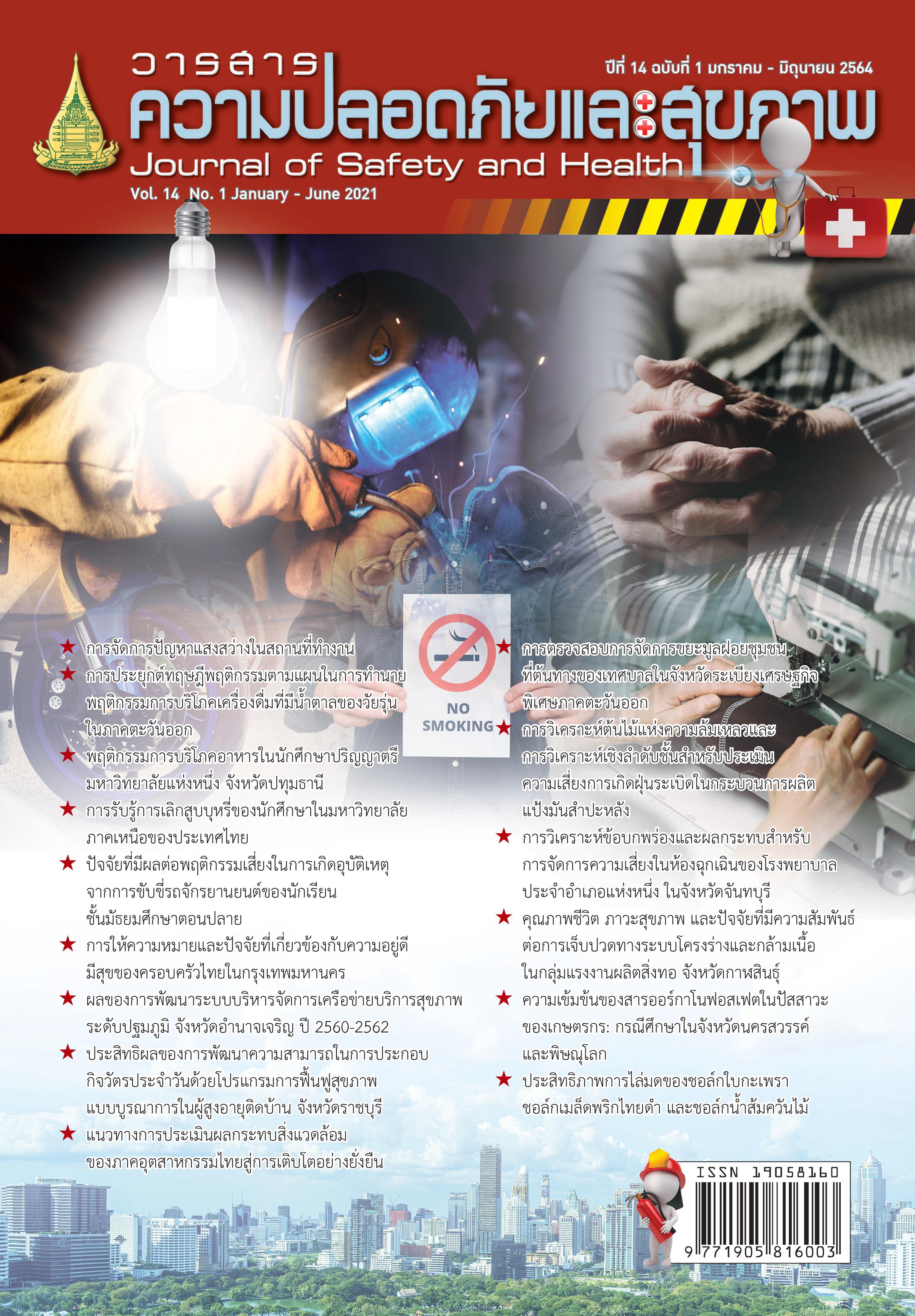ประสิทธิภาพการไล่มดของชอล์กใบกะเพรา ชอล์กเมล็ดพริกไทยดำ และชอล์กน้ำส้มควันไม้
Main Article Content
บทคัดย่อ
การวิจัยเชิงทดลองนี้มีวัตถุประสงค์เพื่อศึกษาประสิทธิภาพการไล่มดของชอล์กใบกะเพรา ชอล์กเมล็ดพริกไทยดำ และชอล์กน้ำส้มควันไม้ การดำเนินการวิจัยแบ่งออกเป็น 5 ระยะ คือ ระยะที่ 1 การเตรียมและสกัดใบกะเพรา เมล็ดพริกไทยดำและน้ำส้มควันไม้ ระยะที่ 2 การผลิตชอล์ก ระยะที่ 3 การทดสอบประสิทธิภาพของชอล์กในการไล่มดในห้องปฏิบัติการ ระยะที่ 4 การทดสอบประสิทธิภาพของชอล์กในการไล่มดในครัวเรือน และระยะที่ 5 การวิเคราะห์องค์ประกอบทางเคมีของชอล์กด้วยเครื่องแก๊สโครมาโทกราฟี – แมสสเปกโตรเมทรี สถิติที่ใช้ในการเปรียบเทียบประสิทธิภาพในการไล่มดคือ One-way ANOVA , Two-way ANOVA และ Fisher LSD
ผลการศึกษาในห้องปฏิบัติการพบว่าชอล์กเมล็ดพริกไทยดำความเข้มข้น 70 เปอร์เซ็นต์มีประสิทธิภาพในการไล่มด 98.33 เปอร์เซ็นต์ ชอล์กน้ำส้มควันไม้ความเข้มข้น 70 เปอร์เซ็นต์มีประสิทธิภาพในการไล่มด 99.33 เปอร์เซ็นต์ และชอล์กใบกะเพราความเข้มข้น 70 เปอร์เซ็นต์มีประสิทธิภาพในการไล่มด 94.50 เปอร์เซ็นต์ ผลการศึกษาในครัวเรือนพบว่าชอล์กเมล็ดพริกไทยสามารถไล่มดได้นาน 360 นาที ชอล์กใบกะเพราสามารถไล่มดได้เป็นเป็นระยะเวลา 180 นาที และชอล์กน้ำส้มควันไม้สามารถไล่มดเป็นระยะเวลา 60 นาที ชอล์กน้ำส้มควันไม้และชอล์กใบกะเพรา พบสาร Acetic acid มากที่สุดจำนวน 66.75% และ 41.26 % ชอล์กพริกไทยดำพบสาร Caryophyllene มากที่สุดจำนวน 24.67%
สรุปชอล์กใบกะเพรา ชอล์กพริกไทยดำ และชอล์กน้ำส้มควันไม้ มีประสิทธิภาพในการไล่มด แต่ยังมีข้อจำกัดเรื่องระยะเวลาในการไล่มด ดังนั้นควรมีการพัฒนาคุณภาพของชอล์กโดยการใช้การเพิ่มส่วนประกอบอื่นๆ เพื่อยืดเวลาและเพิ่มประสิทธิภาพในการไล่มด
Article Details
Journal of Safety and Health is licensed under a Creative Commons Attribution-NonCommercial-NoDerivatives 4.0 International (CC BY-NC-ND 4.0) licence, unless otherwise stated.
เอกสารอ้างอิง
Arutselvi, R., Ponmurugan, P., Saravanan, T. B., & Suresh, R. (2012). Formulation of natural insecticides against Panchaetothrips indicus Bagnall in Curcuma longa L. leaves of PTS and Erode varieties. Journal of Biopesticides, 5, 77.
Babu, R., Murugan, K., Sivaramakrishnan, S., & Thiagarajan, P. (2001). Laboratory studies on the efficacy of neem and the entomopathogenic fungus, Beauveria bassiana on Spodoptera litura Fab. ENTOMON-TRIVANDRUM-, 26(1/4; SPI), 58-61.
Barceloux, D. G. (2009). Pepper and capsaicin (Capsicum and Piper species). Disease-a-Month, 6(55), 380-390.
Bhavya, M. L., Chandu, A. G. S., & Devi, S. S. (2018). Ocimum tenuiflorum oil, a potential insecticide against rice weevil with anti-acetylcholinesterase activity. Industrial Crops and Products, 126, 434-439.
Carroll, C. R., & Risch, S. J. (1983). Tropical annual cropping systems: ant ecology. Environmental Management, 7(1), 51-57.
Chokechaijaroenporn, O., Bunyapraphatsara, N., & Kongchuensin, S. (1994). Mosquito repellent activities of ocimum volatile oils. Phytomedicine, 1(2), 135-139.
deShazo, R. D., & Banks, W. A. (1994). Medical consequences of multiple fire ant stings occurring indoors. Journal of Allergy and Clinical Immunology, 93(5), 847-850.
Johnson, M., Luukinen, B., Buhl, K., & Stone, D. (2010). Deltamethrin technical fact sheet. National Pesticide Information Center, Oregon State University Extension Services: Baker City, OR, USA.
Kamatou, G. P., & Viljoen, A. M. (2008). Linalool–A review of a biologically active compound of commercial importance. Natural Product Communications, 3(7), 1934578X0800300727.
Lee, C.-Y. (2002). Tropical household ants: pest status, species diversity, foraging behavior and baiting studies. Paper presented at the Proceedings of the 4th International Conference on Urban Pests. Pocahontas Press, Blacksburg.
Marisi, M. R. G. (1996). Insect repellent: Google Patents.
Müller, G. C., Junnila, A., Butler, J., Kravchenko, V. D., Revay, E. E., Weiss, R. W., et al. (2009). Efficacy of the botanical repellents geraniol, linalool, and citronella against mosquitoes. Journal of Vector Ecology, 34(1), 2-8.
Ojimelukwe, P., & Adler, C. (1999). Potential of zimtaldehyde, 4-allyl-anisol, linalool, terpineol and other phytochemicals for the control of the confused flour beetle (Tribolium confusum J. d. V.)(Col., Tenebrionidae). Anzeiger für Schädlingskunde= Journal of pest science, 72(4), 81-86.
Rizali, A., Bos, M. M., Buchori, D., Yamane, S., & Schulze, C. H. (2008). Ants in Tropical Urban Habitats: The Myrmecofauna in a Densely Populated Area of Bogor, West Java, Indonesia. HAYATI Journal of Biosciences, 15(2), 77-84.
Tavares, M., da Silva, M. R. M., de Oliveira de Siqueira, L. B., Rodrigues, R. A. S., Bodjolle-d'Almeida, L., dos Santos, E. P., et al. (2018). Trends in insect repellent formulations: A review. International Journal of Pharmaceutics, 539(1), 190-209.
Thavara, U., Tawatsin, A., Bhakdeenuan, P., Wongsinkongman, P., Boonruad, T., Bansiddhi, J., et al. (2007). Repellent activity of essential oils against cockroaches (Dictyoptera: Blattidae, Blattellidae, and Blaberidae) in Thailand. Southeast Asian J Trop Med Public Health, 38(4), 663-673.
จารุวรรณ วิโรจน์. (2563). คุณสมบัติทางเคมีของน้ำส้มควันไม้จาก ต้นสะเดา ต้นยูคาลิปตัส ต้นข้าวโพด และใบมะม่วง. วารสารวิทยาศาสตร์และเทคโนโลยี, 1(39), 136-143.


